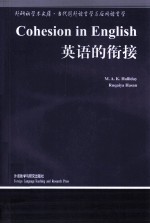图书介绍
英语的衔接pdf电子书版本下载

- (澳)韩礼德(Halliday.M.A.K.),(澳)哈桑(Hasan R.)著 著
- 出版社: 北京:外语教学与研究出版社
- ISBN:7560085296
- 出版时间:2012
- 标注页数:383页
- 文件大小:16MB
- 文件页数:421页
- 主题词:
PDF下载
下载说明
英语的衔接PDF格式电子书版下载
下载的文件为RAR压缩包。需要使用解压软件进行解压得到PDF格式图书。建议使用BT下载工具Free Download Manager进行下载,简称FDM(免费,没有广告,支持多平台)。本站资源全部打包为BT种子。所以需要使用专业的BT下载软件进行下载。如 BitComet qBittorrent uTorrent等BT下载工具。迅雷目前由于本站不是热门资源。不推荐使用!后期资源热门了。安装了迅雷也可以迅雷进行下载!
(文件页数 要大于 标注页数,上中下等多册电子书除外)
注意:本站所有压缩包均有解压码: 点击下载压缩包解压工具
图书目录
1 Introduction 1
1.1 The concept of cohesion 1
1.1.1 Text 1
1.1.2 Texture 2
1.1.3 Ties 3
1.1.4 Cohesion 4
1.2 Cohesion and linguistic structure 6
1.2.1 Texture and structure 6
1.2.2 Cohesion within the sentence ? 7
1.2.3 Cohesion and discourse structure 10
1.2.4 Cohesion as a semantic relation 11
1.3 Cohesion and linguistic context 14
1.3.1 The domain of cohesive relations 14
1.3.2 Text and situation 19
1.3.3 Components of the context of situation, and register 21
1.3.4 The place of cohesion in the linguistic system 26
1.3.5 The meaning of cohesion 28
2 Reference 31
2.1 Endophoric and exophoric reference 31
2.2 Types of reference 37
2.3 Personal reference 43
2.3.1 Semantic distinctions in the personal system 45
2.3.2 Speech roles and other roles 48
2.3.3 Some special kinds of personal reference 52
2.3.3.1 Extended reference, and text reference 52
2.3.3.2 Generalized exophoric reference 53
2.3.4 Personal pronouns, possessive determiners and possessive pro-nouns 54
2.3.5 Cataphoric reference 56
2.4 Demonstrative reference 57
2.4.1 The selective nominal demonstratives: this, these, that, those 59
2.4.1.1 Near and not near: this/these versus that/those 6o 59
2.4.1.2 Singular and plural: this/thot versus these/those 62
2.4.1.3 Head and modifier: this, etc, as pronoun versus this, etc, plus following noun 62
2.4.1.4 Extended reference and reference to‘fact’: this and that 66
2 .4.1.5 Anaphoric and cataphoric demonstratives 68
2.4.2 The 7o 68
2.4.3 Demonstrative adverbs 74
2.4.4 A final note on demonstratives 75
2.5 Comparative reference 76
2.5.1 General comparison 77
2.5.2 Particular comparison 8o 77
2.5.3 A note on so, such and as 84
3 Substitution 88
3.1 Substitution and ellipsis 88
3.1.1 Substitute and reference 88
3.1.2 Types of substitution 9o 88
3.2 Nominal substitution 91
3.2.1 The meaning of substitute one/ones 92
3.2.2 Conditions of use of the nominal substitute 95
3.2.3 The word one other than as substitute 98
3.2.3.1 Personal pronoun one 98
3.2.3.2 Cardinal numeral one 98
3.2.3.3 Indefinite article one 100
3.2.3.4 ‘Pro-noun’ one 102
3.2.4 Summary of uses of one 104
3.2.5 Nominal substitute same 105
3.2.5.1 say the same 107
3.2.5.2 do the same 108
3.2.5.3 be the same 109
3.2.6 Difference between the same and one(s) as nominal substitutes 110
3.3 Verbal substitution 112
3.3.1 The meaning of the verbal substitute do 113
3.3.2 Conditions of use of the verbal substitute 117
3.3.3 The word do other than as substitute 123
3.3.3.1 Lexical verb do 124
3.3.3.2 General verb do 124
3.3.3.3 Pro-verb do 125
3.3.3.4 Verbal operator do 127
3.3.4 Summary of uses of do 128
3.4 Clausal substitution 130
3.4.1 Difference between clausal and other types of substitution 130
3.4.1.1 Substitution of reported chuses 131
3.4.1.2 Substitution of conditional clauses 134
3.4.1.3 Substitution of modalized clauses 134
3.4.2 Similarity among the types of clausal substitution 135
3.4.3 Some related patterns 137
3.4.3.1 Response forms 137
3.4.3.2 Other uses of so and not 138
3.4.4 Summary of uses of so 139
4 Ellipsis 142
4.1 Ellipsis, substitution and reference 142
4.2 Nominal ellipsis 147
4.2.1 Ellipsis within the nominal group 147
4.2.2 Presupposition of nominal elements 150
4.2.3 Types of nominal ellipsis 153
4.2.3.1 Specific deictics 155
4.2.3.2 Non-specific deictics 157
4.2.3.3 Post-deictics 159
4.2.3.4 Numeratives 161
4.2.3.5 Epithets 163
4.3 Verbal ellipsis 167
4.3.1 Ellipsis within the verbal group 167
4.3.2 Lexical ellipsis 170
4.3.3 Operator ellipsis 174
4.3.4 Presupposition of verbal group systems 176
4.3.4.1 Polarity 176
4.3.4.2 Finiteness and modality 180
4.3.4.3 Voice 182
4.3.4.4 Tense 186
4.3.5 Summary of verbal ellipsis 192
4.3.6 Verbal ellipsis and the clause 194
4.4 Clausal ellipsis 196
4.4.1 Modal and propositional 196
4.4.2 No ellipsis of single elements 202
4.4.3 Ellipsis in question-answer and other rejoinder sequences 206
4.4.3.1 Direct responses (1): yes/no questions 208
4.4.3.2 Direct responses (2): WH-questions 210
4.4.3.3 Indirect responses 212
4.4.3.4 A note on zeugma 214
4.4.3.5 Other rejoinders 214
4.4.4 Ellipsis in‘ reporting-reported’ sequences 217
4.4.4.1 Indirect WH-questions 217
4.4.4.2 Indirect yes/no questions 218
4.4.4.3 Indirect statements 219
4.4.4.4 Ambiguity between indirect statements and indirect questions 220
4.4.4.5 Reports and facts in relation to clausal ellipsis 221
4.4.5 Clausal ellipsis and clause complexes 222
5 Conjunction 226
5.1 Conjunction and other cohesive relations 226
5.1.1 Structural equivalents of conjunctive relations 227
5.1.2 Types of conjunctive expression 230
5.2 Some common conjunctive elements 233
5.2.1 The ‘and’ relation 233
5.2.2 Coordinate and and conjunctive and 235
5.2.3 Other conjunctive elements: but, yet, so, and then 237
5.3 Types of conjunction 238
5.4 Additive 244
5.5 Adversative 250
5.6 Causal 256
5.7 Temporal 261
5.8 Other conjunctive items (continuatives) 267
5.8.1 now 268
5.8.2 of course 269
5.8.3 well 269
5.8.4 anyway 270
5.8.5 surely 270
5.8.6 after all 270
5.9 The clhesive function of intonation 271
6 Lexical cohesion 274
6.1 The class of‘general nouns’ 274
6.2 Types of reiteration 277
6.3 Lexical relations as cohesive patterns 282
6.4 Collocation 284
6.5 The general concept of lexical cohesion 288
7 The meaning of cohesion 293
7.1 Text 293
7.1.1 Length of text 294
7.1.2 Definitiveness of the concept of text 294
7.1.3 Tight and loose texture 295
7.1.4 Imaginary texture 297
7.2 The general meaning of cohesion 298
7.3 The meaning of the different kinds of cohesion 303
7.3.1 General principles behind the different types 304
7.3.2 Reference 308
7.3.3 Substitution and ellipsis 314
7.3.4 Lexical cohesion: reiteration and collocation 318
7.3.5 Conjunction 320
7.3.6 Summary 322
7.4 Cohesion and the text 324
7.4.1 Texture within the sentence■ 325
7.4.2 The texturee of discourse 326
7.4.3 Thee role of linguistic analysis 327
8 The analysis of cohesion 329
8.1 General principles 329
8.2 Summary of cohesion, and coding scheme 333
8.3 Sample texts 340
Bibliography 357
Index 367
文库索引 375